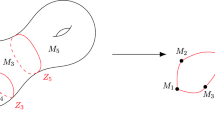Abstract
Sum rules are derived for the quantum wave functions of the Hadamard billiard in arbitrary dimensions. This billiard is a strongly chaotic (Anosov) system which consists of a point particle moving freely on a D-dimensional compact manifold (orbifold) of constant negative curvature. The sum rules express a general (two-point)correlation function of the quantum mechanical wave functions in terms of a sum over the orbits of the corresponding classical system. By taking the trace of the orbit sum rule or pre-trace formula, one obtains the Selberg trace formula. The sum rules are applied in two dimensions to a compact Riemann surface of genus two, and in three dimensions to the only non-arithmetic tetrahedron existing in hyperbolic 3-space. It is shown that the quantum wave functions can be computed from classical orbits. Conversely, we demonstrate that the structure of classical orbits can be extracted from the quantum mechanical energy levels and wave functions (inverse quantum chaology).
Similar content being viewed by others
REFERENCES
M. C. Gutzwiller, Chaos in Classical and Quantum Mechanics (Springer, New York, 1990).
N. Bohr, “On the quantum theory of line-spectra,” Kgl. Vidensk. Selsk. Skrifter, Natur-vidensk. og Mathem. Afd. 8 Raekke IV.1, 1–36 (1918).
M. C. Gutzwiller, “Energy spectrum according to classical mechanics,” J. Math. Phys. 11, 1791–1806 (1970).
M. C. Gutzwiller, “Periodic orbits and classical quantization conditions,” J. Math. Phys. 12, 343–358 (1971).
M. Sieber and F. Steiner, “Generalized periodic-orbit sum rules for strongly chaotic systems,” Phys. Lett. A 144, 159–163 (1990).
A. Selberg, “Harmonic analysis and discontinuous groups in weakly symmetric Riemannian spaces with applications to Dirichlet series,” J. Indian Math. Soc. (N.S.) 20, 47–87 (1956).
D. A. Hejhal, The Selberg Trace Formula for PSL(2, ℝ), Vol. 1 (Lecture Notes in Mathematics, Vol. 548) (Springer, Berlin, 1976).
D. A. Hejhal, The Selberg Trace Formula for PSL(2, ℝ), Vol. 2 (Lecture Notes in Mathematics, Vol. 1001) (Springer, Berlin, 1983).
J. Hadamard, “Les surfaces à courbures opposées et leurs lignes géodésiques,” J. Math. Pures et Appl. 4, 27–73 (1898); see also Oeuvres Complètes de Jacques Hadamard, Vol. 2 (Paris, 1968), pp. 729-775.
J. Hadamard, “Sur le billard non-Euclidien,” Soc. Sci. Bordeaux, Procès Verbaux 1898, 147 (1898).
V. I. Arnold and A. Avez, Ergodic Problems of Classical Mechanics (Addison-Wesley, New York, 1968).
M. C. Gutzwiller, “Classical quantization of a Hamiltonian with ergodic behavior,” Phys. Rev. Lett. 45, 150–153 (1980).
M. V. Berry, “Semiclassical theory of spectral rigidity,” Proc. Roy. Soc. London A 400, 229–251 (1985).
R. Aurich and F. Steiner, “Periodic-orbit theory of the number variance Σ2(L) of strongly chaotic systems,” Physica D 82, 266–287 (1995).
E. B. Bogomolny and J. P. Keating, “Gutzwiller's trace formula and spectral statistics: Beyond the diagonal approximation,” Phys. Rev. Lett. 77, 1472–1475 (1996).
R. Aurich and F. Steiner, “Exact theory for the quantum eigenstates of a strongly chaotic system,” Physica D 48, 445–470 (1991).
D. V. Anosov, “Geodesic flows on closed Riemannian manifolds with negative curvature,” Proc. Steklov Institute of Mathematics 90, 1–235 (1967).
R. Aurich and J. Marklof, “Trace formulae for three-dimensional hyperbolic lattices and application to a strongly chaotic tetrahedral billiard,” Physica D 118, 101–129 (1996).
J. R. Bond, D. Pogosyan, and T. Souradeep, “CMB anisotropy in compact hyperbolic universes I: Computing correlation functions,” Phys. Rev. D 62, 043005-1-20 (Sept. 2000).
J. R. Bond, D. Pogosyan, and T. Souradeep, “CMB anisotropy in compact hyperbolic universes II: COBE maps and limits,” Phys. Rev. D 62, 043006-1-21 (Sept. 2000).
C. Grosche and F. Steiner, “The path integral on the pseudosphere,” Ann. Phys. (N.Y.) 182, 120–156 (1988).
R. Aurich, M. Sieber, and F. Steiner, “Quantum chaos of the Hadamard-Gutzwiller model,” Phys. Rev. Lett. 61, 483–487 (1988).
R. Aurich and F. Steiner, “Periodic-orbit sum rules for the Hadamard-Gutzwiller model, Physica D 39, 169–193 (1989).
R. Aurich and J. Bolte, “Quantization rules for strongly chaotic systems,” Mod. Phys. Lett. B 6, 1691–1719 (1992).
A. F. Beardon, The Geometry of Discrete Groups (Springer, New York, 1983)
Author information
Authors and Affiliations
Rights and permissions
About this article
Cite this article
Aurich, R., Steiner, F. Orbit Sum Rules for the Quantum Wave Functions of the Strongly Chaotic Hadamard Billiard in Arbitrary Dimensions. Foundations of Physics 31, 569–592 (2001). https://doi.org/10.1023/A:1017560808268
Issue Date:
DOI: https://doi.org/10.1023/A:1017560808268




